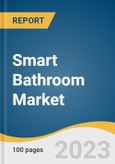The global smart bathroom market size is expected to reach USD 18.76 billion by 2030. The increasing adoption of smart home technologies and the growing trend of home automation are contributing to the rise of smart bathrooms. Consumers are seeking integrated and connected solutions that enhance convenience, efficiency, and comfort in their homes, and smart bathrooms provide a seamless and futuristic experience.
The rising awareness and resultant emphasis on hygiene and wellness are playing a significant role in driving the growth of the market. Smart bathrooms offer features such as touchless faucets, automatic flushing toilets, and sensor-based soap dispensers, which promote better hygiene practices and reduce the spread of germs and bacteria. Additionally, smart bathroom products like smart mirrors with built-in health monitoring capabilities, such as temperature sensors and body composition analysis, cater to the growing interest in personal wellness.
Energy conservation and sustainability concerns are influencing the adoption of smart bathroom technologies. Smart bathroom solutions incorporate energy-efficient features like water-saving fixtures, automated lighting controls, and smart thermostats, which help reduce water and energy consumption. This eco-friendly approach aligns with the global focus on environmental preservation and encourages consumers to opt for smart bathroom products that contribute to sustainability.
The growing prevalence of additional bathrooms in households is driving an increased acceptance of modern and intelligent bathroom products. Over the last fifty years, the average number of bathrooms per person in the United States has doubled. Furthermore, the proportion of homes with ten or more bathrooms has also doubled in the last ten years, as reported in a January 2020 blog post by The Atlantic. The U.S. Census Bureau states that out of the 970,000 single-family homes completed in 2021, 27,000 had one and a half bathrooms or fewer, while 320,000 homes featured three or more bathrooms.
The rising awareness and resultant emphasis on hygiene and wellness are playing a significant role in driving the growth of the market. Smart bathrooms offer features such as touchless faucets, automatic flushing toilets, and sensor-based soap dispensers, which promote better hygiene practices and reduce the spread of germs and bacteria. Additionally, smart bathroom products like smart mirrors with built-in health monitoring capabilities, such as temperature sensors and body composition analysis, cater to the growing interest in personal wellness.
Energy conservation and sustainability concerns are influencing the adoption of smart bathroom technologies. Smart bathroom solutions incorporate energy-efficient features like water-saving fixtures, automated lighting controls, and smart thermostats, which help reduce water and energy consumption. This eco-friendly approach aligns with the global focus on environmental preservation and encourages consumers to opt for smart bathroom products that contribute to sustainability.
The growing prevalence of additional bathrooms in households is driving an increased acceptance of modern and intelligent bathroom products. Over the last fifty years, the average number of bathrooms per person in the United States has doubled. Furthermore, the proportion of homes with ten or more bathrooms has also doubled in the last ten years, as reported in a January 2020 blog post by The Atlantic. The U.S. Census Bureau states that out of the 970,000 single-family homes completed in 2021, 27,000 had one and a half bathrooms or fewer, while 320,000 homes featured three or more bathrooms.
Smart Bathroom Market Report Highlights
- The smart faucets segment is projected to register a CAGR of 11.7% from 2023 to 2030. The emerging concepts of smart bathrooms are increasing the prominence of smart faucets across industries. The increasing inclination toward convenience has led to the development of hands-free faucets, especially in the commercial sector. COVID-19 has also fueled the demand for hands-free faucets
- Commercial application held a market share of 68.3% in 2022 The significant growth of the hotel industry, coupled with the increasing number of eateries and restaurants across the globe, is projected to propel the demand for smart bathrooms over the forecast period. Moreover, the expansion of commercial infrastructure and increasing development across developing economies are supporting this market’s growth
- Asia Pacific is expected to register the fastest CAGR during the forecast period. As per a study published by Google and Accenture, in 2020, the household penetration of connected home devices in Australia was 22%, South Korea was 21%, and Japan was 13%. However, countries such as India, Indonesia, and Thailand each had a penetration rate of 2%. The rising spending power of consumers coupled with the increasing penetration of smart homes is acting as a major catalyst for the smart bathroom industry’s growth in the region
Table of Contents
Chapter 1 Methodology & Scope
Chapter 2 Executive Summary
Chapter 3 Smart Bathroom Market Variables, Trends & Scope
Chapter 4 Consumer Behavior Analysis
Chapter 5 Smart Bathroom Market: Product Analysis and Estimates
Chapter 6 Smart Bathroom Market: Application Analysis and Estimates
Chapter 7 Smart Bathroom Market: Regional Estimates & Trend Analysis
Chapter 8 Smart Bathroom Market - Competitive Landscape
List of Tables
List of Figures
Companies Mentioned
- Jacuzzi Brands, LLC
- Villeroy & Boch AG
- Signature Hardware (Ferguson Enterprises, LLC)
- Pfister (Spectrum Brands, Inc.)
- Kraus USA Plumbing LLC
- Delta Faucet Company
- GROHE AMERICA, INC. (LIXIL Corporation)
- American Standard (LIXIL Corporation)
- Moen Incorporated
- Kohler Co.
- Duravit AG
- Roca Sanitario, S.A
- TOTO LTD.
- Aqualisa
- GetHai, Inc.
- WaterHawk
- Dornbracht AG & Co. KG
Methodology

LOADING...
Table Information
| Report Attribute | Details |
|---|---|
| No. of Pages | 100 |
| Published | July 2023 |
| Forecast Period | 2022 - 2030 |
| Estimated Market Value ( USD | $ 7.52 billion |
| Forecasted Market Value ( USD | $ 18.76 billion |
| Compound Annual Growth Rate | 12.1% |
| Regions Covered | Global |
| No. of Companies Mentioned | 17 |









